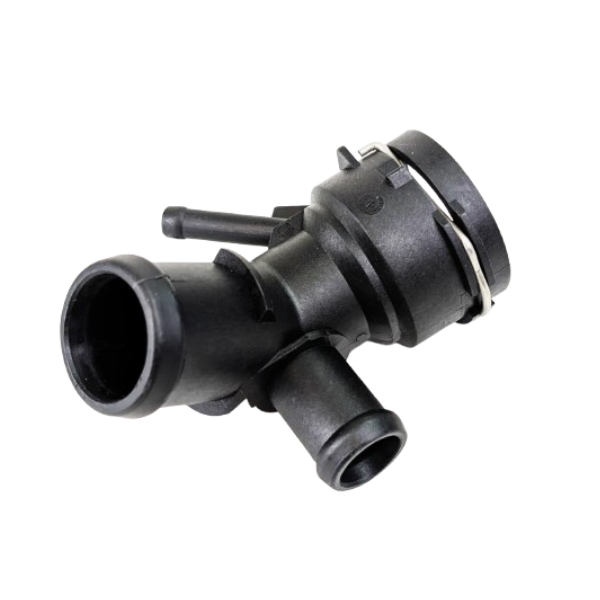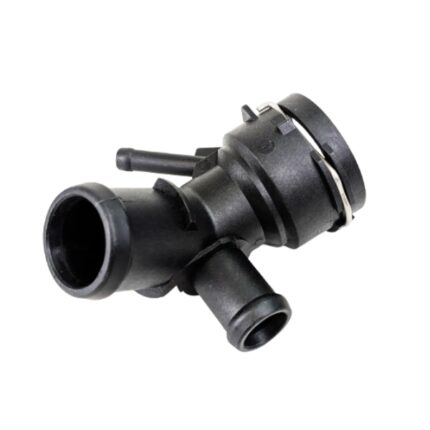Get VW Golf V (1K1) Coolant Flange 1K0122291A in Kenya
A coolant flange is a crucial part of a vehicle’s cooling system, responsible for connecting the engine, hoses, and various cooling components. It provides a passage for the coolant to flow between different parts of the engine and radiator. This guide will dive deep into the role of the coolant flange, its benefits, common issues, and how to properly maintain this component to ensure the longevity and efficiency of a vehicle’s cooling system.
What is a Coolant Flange?
A coolant flange is a molded or machined component, typically made of plastic, aluminum, or metal alloys, designed to connect various coolant lines to the engine or other parts of the cooling system. It acts as a junction point for multiple hoses, allowing coolant to flow between the engine block, thermostat, and radiator. The flange often has several outlets or inlets, each connected to different parts of the vehicle’s cooling system.
Coolant flanges are usually located at the engine block, cylinder head, or near the thermostat housing. They secure the coolant lines, ensuring that coolant is distributed properly throughout the engine to prevent overheating and maintain optimal engine temperatures.
Function of a Coolant Flange
The coolant flange plays several essential roles in the vehicle’s cooling system:
- Coolant Distribution: The primary function of the coolant flange is to distribute coolant between various parts of the engine and the radiator. It connects hoses and passages to ensure that coolant circulates properly, carrying heat away from critical components and maintaining engine temperature.
- Sealing and Preventing Leaks: Coolant flanges are typically equipped with gaskets or O-rings to ensure a proper seal between the engine block, cylinder head, and coolant hoses. This seal prevents coolant from leaking out, which could cause the engine to overheat or lead to inefficient cooling.
- Mounting Point for Sensors and Valves: In modern vehicles, coolant flanges often have ports for temperature sensors or other components like bleed valves. These sensors monitor the engine’s temperature and send information to the vehicle’s ECU (engine control unit) to adjust cooling system performance.
- Facilitating Coolant Flow: The design of the coolant flange ensures that coolant flows smoothly and efficiently from the engine to the radiator and other cooling components. Without proper coolant flow, the engine can overheat, leading to severe damage.
Types of Coolant Flanges
Coolant flanges can vary depending on the vehicle’s design, but they generally fall into a few categories:
- Single-Connection Flanges: These flanges have one connection point for a hose or coolant line. They are used in simpler cooling systems where only a single line needs to be connected to a component, such as a radiator or thermostat housing.
- Multi-Port Flanges: Multi-port coolant flanges have multiple outlets and inlets, often connecting several hoses at once. They are more common in complex engines with several coolant pathways, ensuring that all parts of the engine receive the proper cooling.
- Flanges with Integrated Sensors: Many modern vehicles incorporate sensors into their coolant flanges. These sensors monitor engine temperature and provide feedback to the vehicle’s ECU to manage cooling more efficiently.
Benefits of a Properly Functioning Coolant Flange
- Prevents Engine Overheating: A well-functioning coolant flange ensures that coolant circulates properly throughout the engine, absorbing and dissipating heat. Without proper coolant flow, the engine can overheat, which may cause severe damage to the engine components, including warping of the cylinder head and damage to the pistons.
- Ensures Efficient Cooling System Performance: By maintaining a sealed connection between hoses and the engine, the coolant flange ensures that coolant reaches all parts of the system. This efficient distribution helps the cooling system perform optimally, preventing excessive wear and tear on the engine.
- Prevents Coolant Leaks: A quality coolant flange creates a secure, leak-proof connection between the engine block, cylinder head, and hoses. This prevents coolant from escaping, which could result in overheating, low coolant levels, and eventual engine failure.
- Enhances Engine Performance: Proper engine temperature control improves overall engine performance. When the engine operates within its optimal temperature range, fuel combustion is more efficient, emissions are lower, and power output is maximized.
- Prolongs Engine Life: By preventing overheating and ensuring consistent cooling, the coolant flange helps protect the engine from thermal damage, ultimately prolonging its life. A reliable cooling system reduces wear on engine components, helping the vehicle last longer and perform better over time.
Common Issues with Coolant Flanges
Despite being a relatively simple component, coolant flanges are prone to several issues over time, especially as vehicles age:
- Cracking or Breaking: Coolant flanges are often made of plastic, which can become brittle due to exposure to high temperatures and coolant chemicals. Over time, these flanges may crack or break, leading to leaks and loss of coolant.
- Coolant Leaks: A common problem with coolant flanges is leakage. This can occur due to the degradation of the gasket or O-rings that seal the flange to the engine block or head. Leaks can lead to a drop in coolant levels, causing the engine to overheat.
- Warping: Prolonged exposure to high heat can cause plastic or metal flanges to warp. This warping creates an uneven surface, preventing a proper seal between the flange and engine components, which can result in leaks.
- Gasket Failure: The gasket or O-rings that seal the coolant flange to the engine may deteriorate over time due to heat and chemical exposure. When this happens, the coolant can leak from the flange, leading to potential engine overheating and performance issues.
- Blockage or Restricted Flow: If debris or buildup accumulates inside the coolant flange, it can restrict the flow of coolant through the engine. This restricted flow can cause inefficient cooling and lead to overheating, especially under heavy engine loads.
Signs of a Failing Coolant Flange
- Coolant Leaks:
If you notice coolant pooling under your vehicle or see traces of coolant on the engine, it may indicate a leaking coolant flange. A drop in coolant levels often accompanies this symptom. - Engine Overheating:
If the engine temperature gauge rises above normal operating levels, it could be due to a failing coolant flange that’s restricting coolant flow or allowing coolant to leak out. - Low Coolant Levels:
Constantly needing to top off coolant levels could be a sign of a coolant flange issue. The flange may be leaking coolant, causing it to escape from the system. - Coolant Odor:
A sweet, syrupy smell under the hood or around the vehicle could indicate a coolant leak. Since the coolant is leaking from a failing flange, the odor may become noticeable as it burns off the engine or evaporates. - Steam or Smoke from the Engine Bay:
If the coolant leaks onto hot engine components, it can produce steam or smoke. This can be especially evident when the engine is running or after the vehicle has been driven for a while.
Maintenance Tips for Coolant Flanges
To keep the coolant flange in good working condition, consider the following maintenance practices:
- Regular Inspection: Periodically check the coolant flange for signs of cracking, warping, or leakage. Look for any coolant residue around the flange and inspect the hoses connected to it.
- Replace Worn Gaskets or O-Rings: If the gasket or O-rings that seal the flange to the engine are worn or deteriorated, replace them immediately to prevent leaks. It’s a simple and inexpensive fix that can save you from more significant problems later.
- Use the Correct Coolant: Always use the manufacturer-recommended coolant for your vehicle. The wrong type of coolant can cause damage to the cooling system components, including the coolant flange, and may lead to leaks or clogging.
- Flush the Cooling System Regularly: Regular coolant flushes help remove any debris or contaminants that could clog or damage the coolant flange. Flushing the system also ensures that fresh, clean coolant is circulating through the system, which helps maintain the integrity of the flange and other cooling components.
- Monitor Coolant Levels: Check coolant levels regularly and ensure they are within the recommended range. A sudden drop in coolant levels could indicate a leak in the flange or another part of the cooling system.
- Replace Damaged Flanges Promptly: If the coolant flange is cracked, warped, or otherwise damaged, replace it immediately. Ignoring a damaged flange can lead to severe engine overheating and expensive repairs.
Conclusion
The coolant flange is an essential component of a vehicle’s cooling system, responsible for distributing coolant and ensuring proper engine temperature regulation. A functioning coolant flange prevents leaks, enhances engine performance, and protects the engine from overheating. Regular inspections and maintenance, such as replacing worn gaskets and using the correct coolant, can keep the flange in good condition and extend the life of your vehicle’s cooling system. By understanding the role of the coolant flange and its potential issues, you can prevent costly engine damage and maintain optimal vehicle performance.
Follow us on Facebook for more parts.





Reviews
Clear filtersThere are no reviews yet.